Biostratigraphy I: Rock units and Biozones
Stratigraphy without fossils:
Using the stratigraphic principles of Nicholas Steno: (1668) and the uniformitarian principle of James Hutton (1795), Geologists of the early 19th century could establish the relative ages of formation scale rock units.
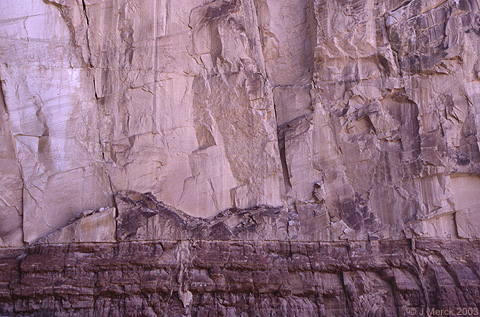
Contact of the Coconino (above) and Hermit Shale formations - Grand Canyon
- Have a distinct lower and upper boundary
- Have a type section: a particular spot where it is well exposed and can be compared to other localities
- Have been laterally continuous during formation (even if its surface exposure isn't)
- Be stratigraphically continuous from top to bottom (except for intertonguing)
- Be mappable on a standard quadrangle-scale map
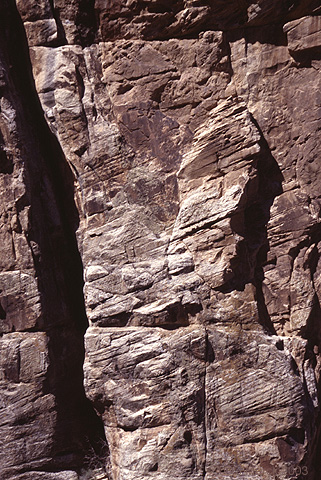
Coconino Formation - Typically have a charactieristic range of lithologies. E.G. the Permian Coconino Formation of northern Arizona. This mature eolian quartzarenite is exposed both in the Grand Canyon (right) and in nearby Walnut Canyon, and is continuous between them beneath the surface.

- Physical proximity: Units have to be seen in direct association.
- Diachronous (i.e. Time transgressive) units representing facies might overlap temporally with adjacent units causing confusion over whether superposition of units actually signified relative age.
Index Fossils, Correlation, and the birth of Biostratigraphy:

- Rock units were characterized by unique sets of fossil taxa.
- These sets of fossil taxa - faunas presumably represent the diversity of things living at the time the sediment was laid down.
- That the occurrance of many fossils was independent of the lithology of the rock.
By noting the fossils present, it became possible to:
- correlate rock units of varying lithologies across vast distances
- establish time horizons in lithologically uniform or diachronous rock units.
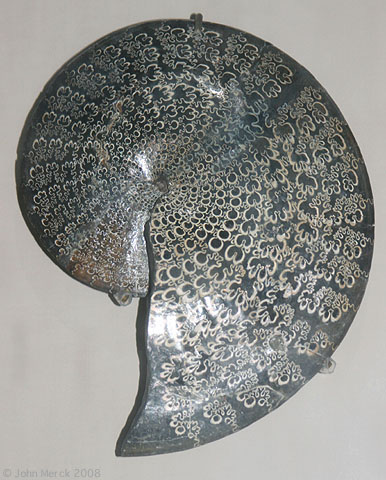
The ammonite Sphenodiscus, restricted to Maastrichthian Stage of Cretaceous.
- Index fossils: Fossils useful in biostratigraphy.
- Common
- Geographically widespread
- Easily preservable
- Diagnosable
- Found in multiple environments (when dead)
- Short species duration
Example: Ammonoids (right), Shelled cephalopods that evolved quickly, so each species lasted only a few million years, but whose remains were distributed worldwide in many environments.
- Facies fossils: In sharp contrast. Fossils of organisms that endured for long periods of geologic time but were linked to a specific environment. Example: Lingula (right), a brachiopod living only in lagoonal mud-flats that has changed very little in the last 500 million years.
Rock units are not time units!
With Steno's and Smith's principles as a basis, geologists define a heirarchy of higher order rock units, including:
- Stages: Groups of formations characterized by distinct faunal assemblages. E.G. the Carnian Stage of the Upper Triassic Series.
- Series: Groups of stages. E.G. the Upper Triassic Series
- Systems: Groups of series. E.G. the Triassic System
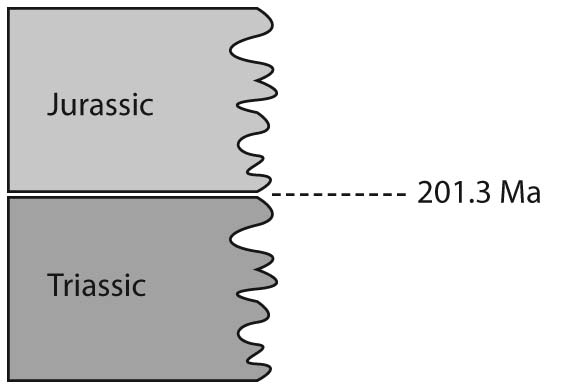
In GEOL 331 we assume that all students, regardless of background, are have memorized the The Geologic Time Scale - simplified version, and are able to interpret a detailed version.
Remember, the numerical dates that we place on their upper and lower boundaries are secondary to the identity of the rock units. For example, the formal base of the Jurassic is a stratotype - a specific contact in the Kuhjoch section of the Karwendel mountains in Austria, between rock units dated to 201.3 Ma. If we were to discover that Triassic rocks below that contact were actually only 200 Ma, we would not say, "Oops. I guess these rocks are Jurassic after all." Rather, we would reassess the age of the boundary between the Triassic and Jurassic.
Subsequent to Smith:
- 1842 - Alcide d'Orbigny (1802-1857) published analysis of Jurassic system of France. He established the concept of stages which he supports by identifying fossil assemblages. He regarded each stage as an interval between separate creations and flood-induced extinctions.
- Roughly contemproaneously, Friedrich Quenstedt (1809-1889) established his own system based on detailed data-bases recording first and last appearance of individual species. Quendstedt rejected d'Orbigny's assemblages as too vague.
- Quendstedt's student Albert Oppel (1831-1865) studied biostratigraphy of France, Switzerland, and England, augmenting Quendstedt's system and developing a system of dignostic aggregates identified by overlapping range zones called Biozones that discriminate fossil faunas on a much finer scale. Oppel is widely viewed as the founder of modern biostratigraphy.
Biozones - Rock units!
Primary data of biostratigraphy: presence or absence of a fossil taxon in a geologic horizon
Last Appearance Datum (LAD): either local or global
First Appearance Datum (FAD): either local or global
Biozone (often just "zone"): Rock unit characterized by one or more taxa that permit it to be distinguished from adjacent rocks.

Types of Biostratigraphic units (and thus rock units):
- Teilzone: Between local FAD & LAD of that taxon. - The truly unambiguous observations!
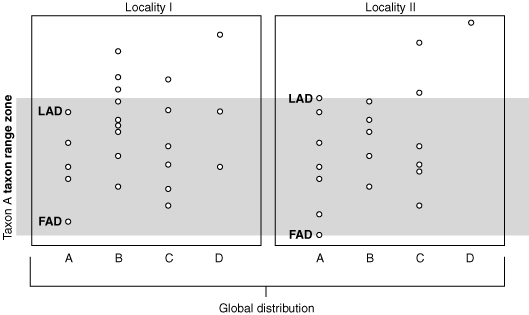
Taxon Range Zone of taxon A - Taxon Range Zone: Between global FAD & LAD of that taxon. - Requires some inferrence - Global correlation of horizons bearing the fossil taxon.
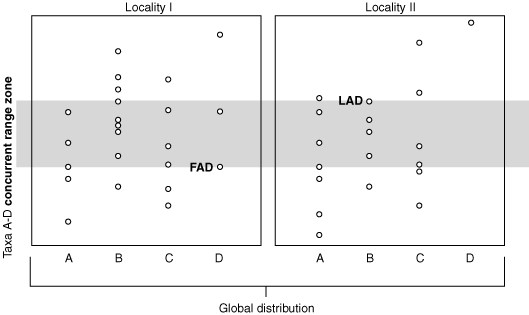
Concurrent Range Zone of taxa A - D - Concurrent Range Zone: Intersection of the taxon range zones of two or more taxa.
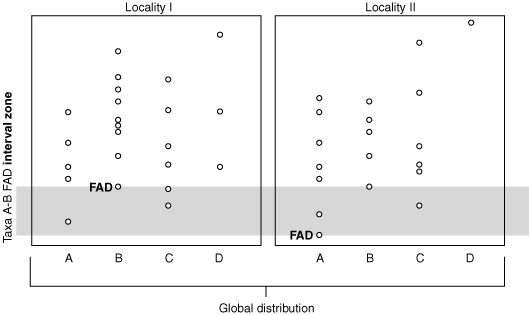
Interval Zone of taxon A and B FADs - Interval Zone: Interval (global) between two successive FADs or two successive LADs
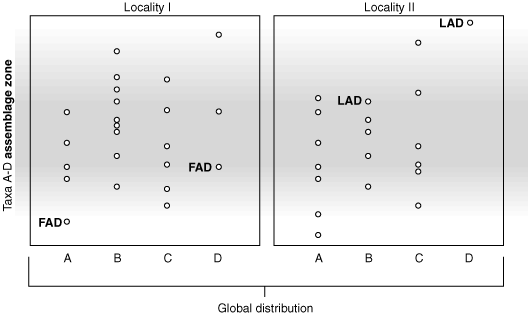
Assemblage Zone of taxa A - D - Assemblage Zone: Characterized by 3 or more taxa in natural assemblage. Biostratigraphers like assemblages because they are free from some of the complications that plague biozones based on a single taxon. (See next lecture) Alas, with assemblages, they must put up with fuzzy boundaries, as the FADs and LADs of the constituent taxa aren't simultaneous.
- Special Case: Oppel Zone: Addresses the shortcomings of the assemblage zone by being defined by the FAD or LAD of one taxon, but characterized by additional taxa of an assemblage. Named for Albert Oppel, the first to use non-arbitrarily defined biozones (1858).
- Special Case: Oppel Zone: Addresses the shortcomings of the assemblage zone by being defined by the FAD or LAD of one taxon, but characterized by additional taxa of an assemblage. Named for Albert Oppel, the first to use non-arbitrarily defined biozones (1858).
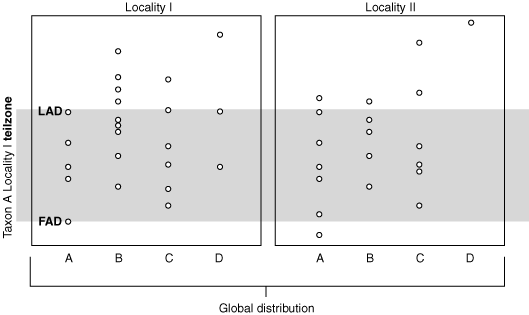
Teilzone of taxon A at locality I.
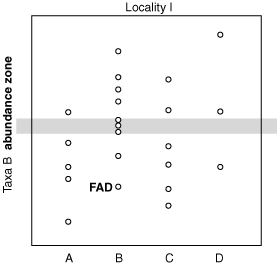
Abundance Zone of taxon B
- The coccolithophorid Braarudosphaera which bloomed in times of global environmental stress.
- Changes in coiling direction of the foram Globotruncana truncatulinoides in response to global temperature changes.
To Next Lecture.
To Previous Lecture.
To Syllabus.


